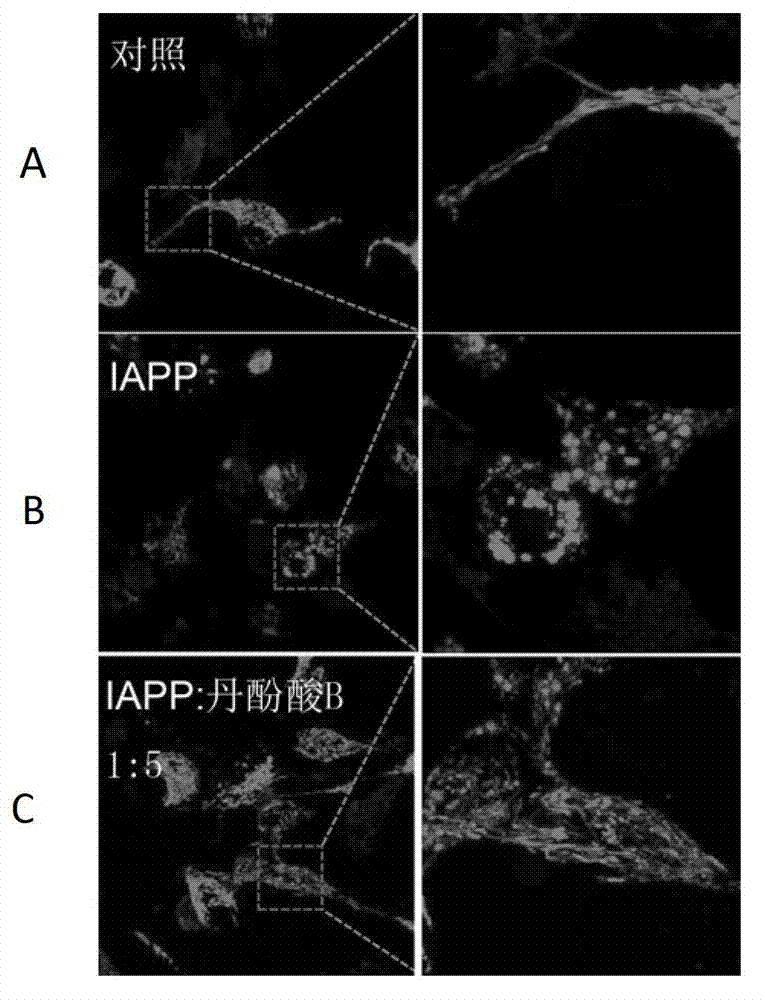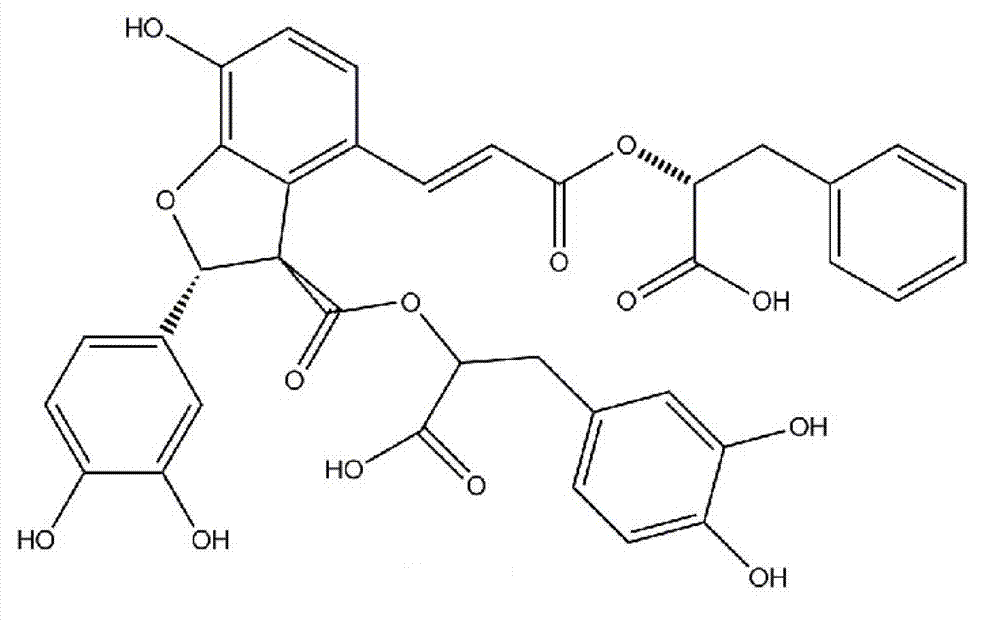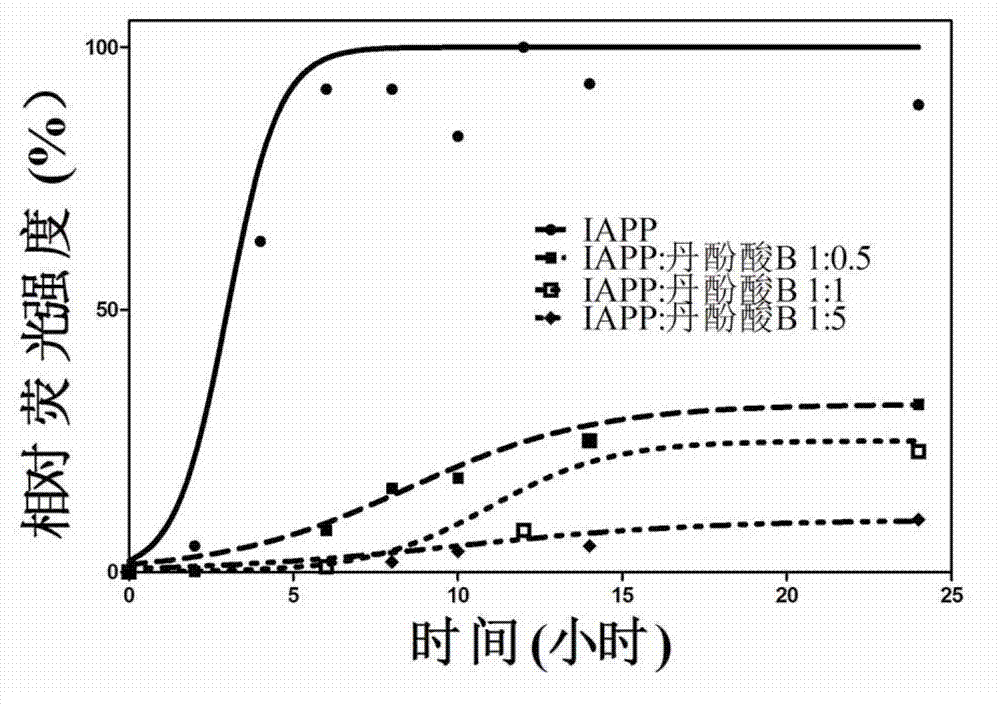Application of danshinolic acid B in inhibition of islet amyloid polypeptide aggregation and treatment of diabetes
A technology of amyloid polypeptide and salvianolic acid, applied in the field of medicine, can solve problems such as aggravation of diabetes and β-cell function damage
- Summary
- Abstract
- Description
- Claims
- Application Information
AI Technical Summary
Problems solved by technology
Method used
Image
Examples
Embodiment 1
[0023] Example 1 Thioflavin-T(ThT) fluorescence assays
[0024] Specific operation: IAPP was dissolved in HFIP and sonicated for 2 minutes, then dissolved in 25 mM PBS (50 mM NaCl), pH 7.4, and diluted to an IAPP solution containing 1% HFIP with a final concentration of 15 μM. At 25°C, they were bathed together with salvianolic acid B at 1, 2, and 5 times the molar ratio (compound / IAPP), and analyzed with a Hitachi 2700 fluorescence analyzer. The detection system contained 25mM PBS, 50mM NaCl, pH 7.4 and 20μM thioflavin- T, excitation and emission wavelengths are 450nm and 482nm.
[0025] The result is as figure 2 As shown, IAPP gradually begins to aggregate as the incubation time increases, and the fluorescence signal intensity increases with the aggregation of IAPP. Then, after adding salvianolic acid B, the fluorescence signal intensity of IAPP decreased significantly, while showing a stable dose-dependent manner. This shows that salvianolic acid B has a significant inh...
Embodiment 2
[0026] Example 2 Electron microscope experiment Transmission electronic microscopy (TEM)
[0027] Specific operation: the samples incubated for 24 hours in Example 1 were used to observe the morphology of the fibers after IAPP aggregation from a morphological point of view by using a scanning electron microscope.
[0028] The result is as image 3 As shown, the IAPP after 24h of incubation alone showed a typical fibrous morphology under the scanning electron microscope (see image 3 A). After co-incubating with salvianolic acid B, observed under the electron microscope, the fibrous morphology gradually decreased in a dose-dependent manner (see image 3 B-D) This shows that salvianolic acid B has a significant inhibitory effect on the aggregation of IAPP.
Embodiment 3
[0029] Example 3 Photocatalytic Cross-Linking of Unmodified Proteins (Photo-induced Cross-Linking of Unmodified Proteins (PICUP) assay)
[0030] Specific operation: IAPP was dissolved in HFIP and ultrasonicated for 2 minutes, dissolved with 10mM PBS (pH7.4) and diluted to a final concentration of 1% HFIP, which was 82 μM of IAPP solution, respectively with 1 and 5 times the molar ratio (compound / hIAPP) of salvianolic acid B was irradiated with incandescent light for 5 s in a dark box under the action of a cross-linking agent. Then, 7.5 μl of loading buffer was added to the reaction solution, denatured at 97° C. for 10 minutes, then electrophoresed on 20% Tricine-Urea gel, and stained with visualized silver staining (Beyotime rapid silver staining kit).
[0031] The result is as Figure 4 As a result, IAPP reacted alone formed more multimers (the second band) after irradiating for 5 seconds; while IAPP reacted with different doses of salvianolic acid B after irradiating for 5...
PUM
 Login to View More
Login to View More Abstract
Description
Claims
Application Information
 Login to View More
Login to View More - R&D
- Intellectual Property
- Life Sciences
- Materials
- Tech Scout
- Unparalleled Data Quality
- Higher Quality Content
- 60% Fewer Hallucinations
Browse by: Latest US Patents, China's latest patents, Technical Efficacy Thesaurus, Application Domain, Technology Topic, Popular Technical Reports.
© 2025 PatSnap. All rights reserved.Legal|Privacy policy|Modern Slavery Act Transparency Statement|Sitemap|About US| Contact US: help@patsnap.com



